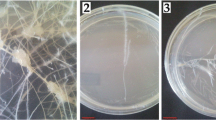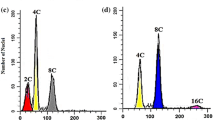Abstract
Hyoscyamine biosynthesis in Datura stramonium hairy roots with different ploidy levels was investigated. For the first time, we report that hairy roots undergo endoreduplication and therefore consist mainly of cells with doupled sets of chromosomes of primary plant tissues, used for Agrobacterium transformation. The alkaloid profiles of hairy roots obtained from diploid and tetraploid plants were similar in terms of the major compounds, but they differed significantly with respect to the minor compounds (here defined as those that accounted for <1% of the total ion current of the alkaloid mixture in gas chromatography–mass spectrometric analyses). Significant differences in the effects of the main nutrients on the growth of the hairy roots obtained from diploid and tetraploid plants and their hyoscyamine contents were observed. The maximal yield of hyoscyamine (177 mg/L) was obtained when hairy roots from tetraploid plants were cultivated in Murashige–Skoog nutrient medium supplemented with 6% sucrose. Time courses of utilization of the main nutrients in the medium during cultivation of D. stramonium hairy root cultures are also presented.










Similar content being viewed by others
References
Matsuda, J., Okabe, S., Hashimoto, T., & Yamada, Y. (1991). Journal of Biological Chemistry, 266, 9460–9464 Medline.
Pitta-Alvarez, S. I., Spolansky, T. C., & Giulietti, A. M. (2000). Enzyme and Microbial Technology, 26, 252–258 DOI 10.1016/S0141-0229(99)00137-4, Medline.
Zabetakis, I., Edwards, R., & O’Hagan, D. (1999). Phytochemistry, 50, 53–56. DOI 10.1016/S0031-9422(98)00490-7.
Bensaddek, L., Gillet, F., Sausedo, J., & Fliniaux, M.–A. (2001). Journal of Biotechnology, 85, 35–40 DOI 10.1016/S0168-1656(00)00372-2, Medline.
Berkov, S., Pavlov, A., Kovatcheva, P., Stanimirova, P., & Philipov, S. (2003). Zeitschrift für Naturforschung, 58c, 42–46.
Baiza, A., Quiroz-Moreno, A., Ruiz, J., & Loyola-Vargas, V. (1999). Plant Cell, Tissue and Organ Culture, 59, 9–17. DOI 10.1023/A:1006398727508.
Stebbins, G. L. (1971). Chromosomal evolution in higher plants. London: Edward Arnold.
Berkov, S., & Philipov, S. (2003). Pharmaceutical Biology, 40, 617–621.
Lavania, U. C. (2005). Plant Genetic Resources, 3, 170–177.
Dhawan, O. P., & Lavania, U. C. (1996). Euphytica, 87, 81–89. DOI 10.1007/BF00021879.
De Jesus-Gonzalez, L., & Weathers, P. J. (2003). Plant Cell Reports, 21, 809–813 Medline.
Pundir, R. P. S., Rao, N. K., & van der Maesen, L. J. G. (1983). Theoretical and Applied Genetic, 65, 119–122. DOI 10.1007/BF00264878.
Berkov, S., & Pavlov, A. (2004). Phytochemical Analysis, 15, 141–145 DOI 10.1002/pca.756, Medline.
Dixon, R. A. (1985). In R. A. Dixon (Ed.), Plant cell culture—A practical approach: Isolation and maintenance of callus and cell suspension cultures pp. 1–20. Oxford: IRL.
Pavlov, A., Georgiev, V., & Ilieva, M. (2005). Process Biochemistry, 40, 1531–1533. DOI 10.1016/j.procbio.2004.01.001.
Sung, L.-S., & Huang, S.-Y. (2000). Biotechnology Progress, 16, 1135–1140 DOI 10.1021/bp000062t, Medline.
Georgiev, M., Pavlov, A., & Bley, Th. (2007). Applied Microbiology and Biotechnology, 74, 1175–1185 DOI 10.1007/s00253-007-0856-5, Medline.
Bayliss, M. W. (1980). International Review of Cytology, 1117, 113–144.
Payne, J., Hamill, J. D., Robins, R. J., & Rhodes, M. J. C. (1987). Planta Medica, 53, 474–478 DOI 10.1055/s-2006–962776, Medline.
Kudo, N., & Kimura, Y. (2002). Plant Biotechnology, 19, 45–52.
Peter, C. L. J., & Ruhu, Q. I. (2008). Trends In Plant Science, 13, 121–127 Medline.
Pavlov, A., & Bley, Th. (2006). Process Biochemistry, 41, 848–852. DOI 10.1016/j.procbio.2005.10.026.
Pavlov, A., Berkov, S., Courot, E., Gocheva, T., Tuneva, D., Pandova, B., & Georgiev, M. (2007). Process Biochemistry, 42, 734–739. DOI 10.1016/j.procbio.2006.12.006.
Patterson, S., & O'Hagan, D. (2002). Phytochemistry, 61, 323–329. DOI 10.1016/S0031-9422(02)00200-5.
Witte, L., Müller, K., & Alfermann, H.-A. (1987). Planta Medica, 52, 192–197.
Ionkova, I., Witte, L., & Alfermann, H. A. (1994). Planta Medica, 60, 382–384 DOI 10.1055/s-2006–959509, Medline.
Ilieva, M., & Pavlov, A. (1997). Applied Microbiology and Biotechnology, 47, 683–688. DOI 10.1007/s002530050995.
Shin, K. S., Chakrabarty, D., Ko, J. Y., Han, S. S., & Paek, K. Y. (2003). Plant Growth Regulation, 39, 187–193. DOI 10.1023/A:1022525308389.
Su, W. W. (1995). Applied Biochemistry and Biotechnology, 50, 189–229. DOI 10.1007/BF02783455.
Robins, R. G., Parr, A. G., Payne, J., Walton, N. J., & Rhodes, M. G. C. (1990). Planta, 181, 414–422. DOI 10.1007/BF00195896.
Parr, A., Payne, J., Eagles, J., Chapman, R., Robins, R., & Rhodes, M. (1990). Phytochemistry, 29, 2545–2550. DOI 10.1016/0031-9422(90)85185-I.
Acknowledgement
This research was supported by a Marie Curie Fellowship of the European Community program “Development Host Fellowships” under contract number HPMD-CT-2001-00092, DAAD, references number D/05/01303, and the Bulgarian Science Fund.
Author information
Authors and Affiliations
Corresponding author
Rights and permissions
About this article
Cite this article
Pavlov, A., Berkov, S., Weber, J. et al. Hyoscyamine Biosynthesis in Datura stramonium Hairy Root In Vitro Systems with Different Ploidy Levels. Appl Biochem Biotechnol 157, 210–225 (2009). https://doi.org/10.1007/s12010-008-8264-6
Received:
Accepted:
Published:
Issue Date:
DOI: https://doi.org/10.1007/s12010-008-8264-6




